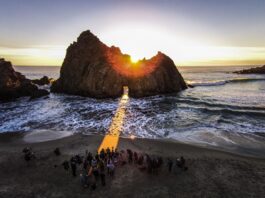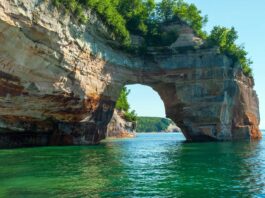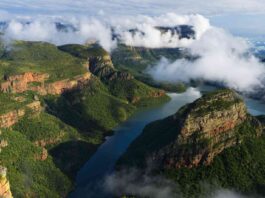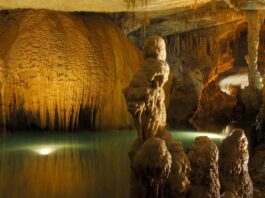Da Dia Reef, located in Phu Yen Province, Vietnam, is a natural wonder known for its unique geological formations and cultural significance. This geological marvel is characterized by a vast expanse of hexagonal basalt columns, resembling a giant honeycomb or a chessboard. The columns are the result of ancient volcanic activity and subsequent cooling and solidification of lava flows.

The reef is not only a geological wonder but also holds cultural importance for the local population. It is associated with various myths and legends of the Cham people, an ethnic group indigenous to the region. Many visitors are drawn to Da Dia Reef not only for its geological fascination but also for its historical and cultural significance.
Tourists visit this site to marvel at the breathtaking natural formations and to learn about the local legends and history associated with the area. It is a unique and significant destination for both geology enthusiasts and those interested in the rich cultural tapestry of Vietnam.
Contents
Location and Geography

Da Dia Reef is situated in Phu Yen Province on the southeastern coast of Vietnam, approximately 21 kilometers south of Tuy Hoa, the provincial capital. The reef is located along the shoreline of An Ninh Dong Commune, Tuy An District, and it stretches for about 2 kilometers along the coast.
Geographically, the reef is characterized by its distinctive hexagonal basalt columns, formed from ancient volcanic activity. These columns are tightly packed together and create a fascinating natural mosaic that extends from the coastal area into the sea. The interlocking hexagonal shapes make Da Dia Reef a unique geological formation and a stunning sight for visitors. The geological processes that led to the creation of these columns involved the cooling and solidification of lava flows, resulting in the unique hexagonal pattern that has made this location famous.
Geological Formation of Da Dia Reef

Da Dia Reef’s unique geological formation can be attributed to a series of volcanic and geological processes. Here’s how Da Dia Reef was formed and its distinctive features:
- Volcanic Origins: The reef’s formation began with volcanic activity millions of years ago. Molten lava from volcanic eruptions in the region flowed into the sea.
- Rapid Cooling and Solidification: As the lava came into contact with the cold seawater, it rapidly cooled and solidified. This rapid cooling led to the development of the distinctive hexagonal columns. The cooling process resulted in contraction and cracking of the lava, which formed the hexagonal patterns we see today.
- Geological Erosion: Over time, geological erosion from waves, tides, and weathering processes sculpted the columns and exposed them along the shoreline. The columns became more defined and visible through the erosional forces of nature.
Unique Features:
- Hexagonal Columns: The most distinctive feature of Da Dia Reef is the hexagonal pattern of the basalt columns. These columns fit together like a giant honeycomb or chessboard, creating a visually striking and unique natural mosaic.
- Honeycomb Structure: The reef’s appearance is often likened to a honeycomb, with the columns rising vertically from the shore and extending into the sea. This feature is quite rare in natural formations.
Comparison with Other Geological Formations: Da Dia Reef is often compared to other similar geological formations around the world, such as the Giant’s Causeway in Northern Ireland and the Devil’s Postpile in California, USA.
- Giant’s Causeway: The Giant’s Causeway features hexagonal basalt columns that were formed by ancient volcanic activity. However, the columns at the Giant’s Causeway are taller and extend over a larger area, and they are characterized by a similar striking hexagonal pattern.
- Devil’s Postpile: While the Devil’s Postpile also consists of basalt columns, they are not hexagonal like those at Da Dia Reef. Instead, they have more irregular, polygonal shapes.
Da Dia Reef remains distinct due to its vast expanse of tightly packed hexagonal columns, making it a remarkable geological formation with a unique and visually appealing pattern that sets it apart from other similar sites worldwide.
History and Cultural Significance

Da Dia Reef holds not only geological significance but also cultural and historical importance, particularly for the local Cham people and the broader Vietnamese population. Here’s a brief overview of its history and cultural significance:
- Cham Heritage: The Cham people, an indigenous ethnic group in Vietnam, have a long history and deep cultural ties to the region where Da Dia Reef is located. They have inhabited this area for centuries and have their own cultural and religious traditions.
- Mythological Significance: Da Dia Reef is associated with various myths and legends within Cham culture. Some of these stories tell of giant sea serpents that created the reef’s hexagonal pattern by dragging their tails across the sea floor. These legends are an integral part of the local folklore and add to the cultural mystique of the site.
- Religious Importance: The Cham people practice a unique form of Hinduism and have built several temples and religious sites in the region. These temples often serve as places of worship and pilgrimage for the Cham community and are considered sacred.
- Tourist Attraction: Over the years, Da Dia Reef has become a popular tourist attraction in Vietnam, drawing visitors from across the country and around the world. Tourists come to marvel at the geological wonders and to learn about the cultural heritage associated with the site.
- Preservation and Conservation: Efforts have been made to preserve and protect Da Dia Reef due to its historical and cultural significance. Conservation initiatives aim to maintain the site’s natural beauty while respecting its cultural importance to the Cham people.
- UNESCO Recognition: Da Dia Reef, along with other Cham historical and cultural sites in the region, has been submitted for consideration as a UNESCO World Heritage Site. This recognition would further highlight its cultural value and contribute to its preservation.
In summary, Da Dia Reef’s history and cultural significance are deeply intertwined with the heritage of the Cham people, their myths and legends, and the religious practices associated with the site. Its role as a tourist attraction and potential UNESCO recognition underscore its cultural importance within Vietnam’s rich tapestry of history and tradition.
Visitor Information of Da Dia Reef

If you’re planning to visit Da Dia Reef in Phu Yen Province, Vietnam, here is some essential visitor information to help you make the most of your trip:
1. Location: Located approximately 21 kilometers south of Tuy Hoa, the capital of Phu Yen Province, in An Ninh Dong Commune, Tuy An District.
2. Best Time to Visit: The best time to visit Da Dia Reef is during the dry season, which typically runs from January to August. The weather is more pleasant, and the sea is calmer during this period. It’s also advisable to visit during low tide to get a better view of the exposed basalt columns.
3. Opening Hours: Da Dia Reef is an open, natural attraction, and there are no strict opening or closing hours. You can visit during daylight hours, but it’s recommended to arrive in the morning or late afternoon for the best lighting and fewer crowds.
4. Entrance Fees: There is usually a small entrance fee for visitors, which helps with the preservation and maintenance of the site. Be prepared to pay this fee upon arrival.
5. Guided Tours: While you can explore Da Dia Reef independently, guided tours are available and can provide you with valuable insights into the geological and cultural aspects of the site. Guides can share local myths and stories associated with the reef.
6. What to Bring:
- Comfortable walking shoes for exploring the rocky terrain.
- Sunscreen and a hat to protect yourself from the sun.
- Water and snacks, as there may be limited amenities nearby.
- A camera to capture the stunning geological formations and beautiful coastal scenery.
7. Respect Local Customs: When visiting a site with cultural and religious significance like Da Dia Reef, it’s important to be respectful. Follow any guidelines provided by local authorities and avoid any behavior that might be considered disrespectful.
8. Nearby Attractions: Phu Yen Province offers more than just Da Dia Reef. You can explore other beautiful coastal areas, visit temples, and enjoy local cuisine in the region.
9. Accommodation: Tuy Hoa, the provincial capital, offers a range of accommodations, including hotels and guesthouses, for tourists planning to stay in the area.
10. Travel Essentials: Ensure you have the necessary travel documents, and consider arranging transportation to and from Da Dia Reef in advance.
Remember to check for any updates on entrance fees or local regulations before your visit, as these details may change over time. Enjoy your visit to Da Dia Reef and take in the natural beauty and cultural significance of this unique geological wonder.






